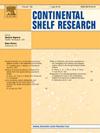A century of tidal evolution around the Panama Canal
IF 2.1
3区 地球科学
Q2 OCEANOGRAPHY
引用次数: 0
Abstract
As one of the most vital passageways worldwide, the Panama Canal plays essential roles in global trade and maritime logistics. Sea levels around the Panama Canal are dominated by ocean tides but local tidal evolution is still unexplored to date, which motivates present study. Two secular tide gauges longer than 110 years (Cristobal and Balboa) around the Panama Canal are analyzed to explore multi-time scale tidal variability. It is found that observed nodal modulations of major constituents are generally consistent with the equilibrium tidal theory. M4 and Mf nodal modulations notably deviate from the theory possibly due to non-linear processes. Long-term trends exist in main semi-diurnal tides, while main diurnal tides do not have significant secular trends. It is worth mentioning that M4 and MS4 amplitudes at Cristobal have halved in the past century. Moreover, tidal parameters of major constituents at Cristobal and Balboa show abnormal mutations in 1908, 1990–1998, and 2013–2018. As a result of changing tides, tidal asymmetries at Cristobal are significantly weakened while the number of high tides per year is notably decreased. Tides at Balboa are almost symmetric. Tidal regimes at Cristobal can periodically shift between mixed diurnal tides and mixed semi-diurnal tides following the 18.61-year nodal cycle. However, such regime shift has disappeared since 1997 due to secular negative trends in M2 amplitudes. In general, the findings of this study can be helpful for ships navigating in the Panama Canal.
巴拿马运河周边一个世纪的潮汐演变
作为全球最重要的通道之一,巴拿马运河在全球贸易和海运物流中发挥着至关重要的作用。巴拿马运河附近的海平面主要受海洋潮汐的影响,但当地潮汐的演变至今仍未得到探索,这也是本研究的动机所在。本研究分析了巴拿马运河周围两个超过 110 年的常规验潮仪(克里斯托巴尔验潮仪和巴尔博亚验潮仪),以探索多时间尺度的潮汐变化。研究发现,观测到的主要成分的节点模态与平衡潮汐理论基本一致。M4 和 Mf 节点调制明显偏离理论,可能是由于非线性过程造成的。主半日潮存在长期趋势,而主日潮没有明显的世俗趋势。值得一提的是,克里斯托巴尔的 M4 和 MS4 振幅在上个世纪减小了一半。此外,克里斯托巴尔和巴尔博亚主要成分的潮汐参数在 1908 年、1990-1998 年和 2013-2018 年出现异常突变。由于潮汐的变化,克里斯托巴尔的潮汐不对称性明显减弱,同时每年的高潮次数显著减少。巴尔博亚的潮汐几乎是对称的。克里斯托巴尔的潮汐系统会根据 18.61 年的交点周期在混合日潮和混合半日潮之间周期性地转换。然而,自 1997 年以来,由于 M2 振幅的长期负值趋势,这种潮汐机制的转变已经消失。总之,这项研究的结果对在巴拿马运河航行的船只很有帮助。
本文章由计算机程序翻译,如有差异,请以英文原文为准。
求助全文
约1分钟内获得全文
求助全文
来源期刊

Continental Shelf Research
地学-海洋学
CiteScore
4.30
自引率
4.30%
发文量
136
审稿时长
6.1 months
期刊介绍:
Continental Shelf Research publishes articles dealing with the biological, chemical, geological and physical oceanography of the shallow marine environment, from coastal and estuarine waters out to the shelf break. The continental shelf is a critical environment within the land-ocean continuum, and many processes, functions and problems in the continental shelf are driven by terrestrial inputs transported through the rivers and estuaries to the coastal and continental shelf areas. Manuscripts that deal with these topics must make a clear link to the continental shelf. Examples of research areas include:
Physical sedimentology and geomorphology
Geochemistry of the coastal ocean (inorganic and organic)
Marine environment and anthropogenic effects
Interaction of physical dynamics with natural and manmade shoreline features
Benthic, phytoplankton and zooplankton ecology
Coastal water and sediment quality, and ecosystem health
Benthic-pelagic coupling (physical and biogeochemical)
Interactions between physical dynamics (waves, currents, mixing, etc.) and biogeochemical cycles
Estuarine, coastal and shelf sea modelling and process studies.
 求助内容:
求助内容: 应助结果提醒方式:
应助结果提醒方式:


